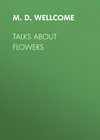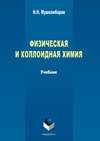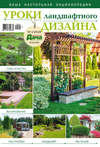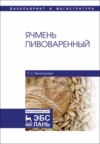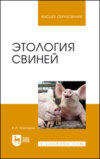Читать книгу: «Talks About Flowers»
PREFACE
To all Flower Lovers who may read these pages, we come with kindly greetings. To you we dedicate our Work.
Encouraged by the many testimonials of favor with which our Flower Sketches have been received, which have appeared in the Boston Journal, Portland Transcript, and the leading Floricultural journals, we were induced to prepare this volume, intending it to be made up chiefly of those articles revised and enlarged for this purpose; but after entering upon this work, we found so little that was adapted for use, nearly every page has been written while the sheets were passing through the press.
Before we were aware, the printed matter had exceeded our proposed limits, and we were obliged to enlarge the work by additional pages, and even then omit our chapter of "Floricultural Notes," for we wished to put the book at a low price, that it might reach the masses. As it is, we are sure that we have given you a great amount of valuable information, and just such as amateurs need, respecting the habits and requirements of those flowers which are best adapted for general cultivation, and in a form specially new and attractive, combining the history and literature of flowers, with description and mode of culture.
It may be deemed strange that we should omit from a work of this character a "Talk" about the Queen of Flowers, but the subject was so full that we thought best to devote the space to other varieties and refer our readers to our recently published "Essay on Roses,"—advertised in another part of this work—in which they will find the subject fully treated.
We would here acknowledge our obligation to Mr. James Vick for the beautiful Bouquet of Flowers which constitutes our Frontispiece.
Mrs. M. D. Wellcome.
Yarmouth, Me., June 9, 1881.
Introduction
"Thank God for the beautiful flowers,
That blossom so sweetly and fair;
They garnish this strange life of ours,
And brighten our paths everywhere."
Dexter Smith.
I HAVE been thinking for some time of writing a few articles about flowers, not for the entertainment nor instruction of those who have extensive gardens artistically laid out, and fine conservatories with skilled gardeners to care for the rare and costly plants, but for those, who, like myself, have only a few beds filled with flowers, cared for by one's own self.
Every year there is a marked advance in the floricultural kingdom. Books and periodicals devoted to flower culture are on the increase; florists are enlarging their domain; catalogues are scattered broadcast, and as free as autumn leaves, some of them beautiful with their colored plates, handsome enough to frame. Very many of the literary, religious, and political journals of the day have their floral department, in which the ladies gossip of their experience and exchange opinions, and we doubt if any column is read with greater interest.
What recreation for the mind and body more pure, refining, healthful, than that of the cultivation of flowers? How they reveal the Father's love, and wisdom, and power! How perfect his work! Very fully have I realized this, as I have examined bud, blossom, and leaf under the microscope. Its magnifying power when applied to man's work, reveals coarseness and imperfection, but in God's work only reveals new beauties, and greater perfectness. The tiny flower, the details of which cannot be perceived by the eye unaided, when magnified, surprises us with its loveliness. We wonder and adore that Being whose hand created its perfect form and arranged its tints with so much harmony. The study of flowers with the microscope is one of never failing delight, and one needs not the costly instrument to enjoy this study. The round open glass, the size of a half dollar, and costing the same, serves every needful purpose.
Not only have I enjoyed the examination of flowers, but also of insect life, specially of those terrible pests to our rosebushes and some other plants—the aphides. I have closely watched their development, from the tiny egg to the portly insect, so filled with the juice of the leaf, that like it, he is green all over. First I observe a little speck of red in the egg—then it has slight motion—next it runs about, and the spot is a little larger, sometimes it is black. Sometimes the baby aphis is all red. Now and then I find a different sort mixed up with them; the body is much larger and transparent white. Some have wings. Skeletons, or more properly, cast-off skins, are often seen, but with the closest observation I have never been able to trace these to their source. Once, I was sure that a fellow was divesting himself of his overcoat, and I watched him till my eyes ached too badly for further investigation.
These insects are the cows of a certain species of ant, and I am sure they are quite welcome to all I have, provided they will have their yard on other premises, though I would like to detain them long enough to see the milking process. Some have seen it and written about it, so, strange as it seems, it is no fiction.
In this series of articles which I have entitled "Talks About Flowers," I shall, in a very informal manner, talk to you about just those matters pertaining to the flower garden, in which beginners and amateurs are interested; to this class I belong; I am not a skilled florist, my experience is limited; I am only a student in the lower classes of floriculture, but I dearly love my lessons. I am acquiring knowledge both from books and personal observation, and I shall enjoy imparting to those not so favored with time and resources the results of this study, believing it will be duly appreciated by my readers, and their interest in the cultivation of flowers be thereby increased. I shall talk to you about the sowing of seeds, the arrangement of your garden, the plants with which to stock it, treating of them historically and descriptively, with mode of culture. I shall talk to you about the most desirable bulbs, about climbing plants, hanging pots, and the window garden, and shall seek to meet in all these the wishes of many inquirers.
A Talk to Farmers' Wives
"Not useless are ye flowers, though made for pleasure,
Blooming in field and wood by day and night;
From every source your presence bids me treasure
Harmless delight."
"ONCE more I take my pen in hand," as the old time epistle was wont to begin. While a "Young Farmer" discourseth of matters pertaining to the farm, I propose to talk to farmers' wives and daughters of matters relating to the flower garden. This article is specially dedicated to them, and not to them as a whole, but to that class among them who take no periodical devoted to flower culture, and find no time even to study the various catalogues scattered broadcast, as sure precursors of spring as are the falling leaves of autumn. Therefore you who have your floral papers, your bay windows filled with plants, or your fine conservatories, whether a farmer's wife or not, this is not written for you, and you need not read any further.
There are many farmers' wives who give little attention to the cultivation of flowers. Busy lives the most of them lead, and their indoor work shuts them off largely from the enjoyment of those beauties nature has so lavishly spread around them. It is a pity that any of them should say, "I have no time to waste over flowers; they bring neither food nor clothing."
Call that wasted time when tired, nervous, fretful perhaps, you leave the heated rooms and run out to see if the seeds you sowed last week have come up, or how the seedlings you set out are thriving? To look at that opening rosebud, pick off the withered leaves from the geranium, stir the earth a bit around that heliotrope, and linger over the dear little pansies as their bright faces are up-turned to greet you and cheer you with their diversified beauty? Gather a few; they will bloom all the more because of it. There, now, don't you feel nicely rested? The feeling of fretfulness is all gone. Refreshed in body and mind, you resume your housework, and accomplish it much more effectively than if you had kept right on, so tired and all out of sorts. Better far these moments of out-door recreation than blue pill or bitters. All this is anticipatory of the "good time coming" to you this summer. That kind husband of yours when he goes to the store to buy his garden seeds, or order them from abroad, is going to include an equal number of flower seeds. He would have done it long ago but he did not think anything about it. But you are going to give him a hint this spring. You can tell him that in the general seed box there is one corner where are certain dainty little packages labeled Candytuft—purple, carmine, white or mixed; Mignonnette, Aster, Balsam, Pink, Petunia, Sweet Peas, etc., etc., and you tell him that those Sweet Peas bloom the most fragrant blossoms for five months, while his "Extra Early," whether "Blue Peter" or "Blue Tom Thumb," last only a little while. So as he goes on his way he will think to himself, "Wife works hard; she makes capital butter and keeps the house real tidy, and I guess I must indulge her." When he returns home he gives you those little packages, in each tiny brown seed of which there lies hidden a beautiful life—a life that shall, by loving care, develop "the red, white and blue" in settings of emerald, the influence of which shall be felt by the entire household, and bring forth a fruitage of brightness, gladness and love.
It may be that you live remote from the village store, or perhaps there may not be kept there a good, reliable assortment of flower seeds, so I will tell you what to do in that case, for I wish to be helpful every step of the way. You must send to some good florist for what you want, enclosing stamps, if for an amount less than one dollar. You have your seeds now, and some of them need to be started in the house in order to secure early flowers, Asters, Petunias, Pinks, Pansies, Snapdragon and Sweet Peas. Sift your earth through a coarse sieve. A little sharp sand is good to mix with it. Shallow boxes are best, except for the peas. I use cigar boxes. Dampen the earth, then sow thickly in rows, cover lightly with more soil, dampen again, label, cover with paper so that the moisture may not evaporate rapidly, and place in a sunny window. Daily sprinkle through a fine rose pot, or with your fingers lightly if you have none. However good your seeds may be, they will not grow if kept dry, and will rot if kept too wet. The seedlings must be nursed with care, not too much sun while tender. I do not thin out mine till I transplant to the border, but many do, potting them singly. Peas can be set out earliest of any. Sunny days in May often tempt one to bed out their tender plants, and sow seed in open ground; then come cold nights, when the fragile seedlings need a hot soapstone to their feet. It is best to wait till warm weather is fully established, and then choose a cloudy day for the work. Protect from the sun's rays till the plants are established in their new quarters. Now, all this looks like much work and care, I know, but it is only a little work, a little care each day, and it is a work that will be a restful change, and bring you better health and better feelings, and when you gather the lovely flowers from the seeds you have sown and cultured, you will not say: "My time was all misspent."
A Talk About "The Wild Garden"
The lengthened days have come,
The busiest of the year—
WHEN the annual house cleaning treads heavily on the toes of spring gardening, and one feels tempted to crowd the work of two days into one, though sufficient for the present is the work thereof. The bright warm days draw one forth to spend "an hour or two" they say, and they mean it too—with shovel or spade in hand to prepare the flower beds, but the air is so refreshing, and there is so much to be done, that they keep on "a little while longer," "just a few minutes more," till Sol pours his burning rays down upon them with the unmistakable assurance that it is near the hour of noon.
These are the days that try men's souls, and women's, too; days when one wishes with Dudley Warner for a "cast iron back," but would fain add the improvement of rubber hinges; days when the inquiry is often provoked, "Will it pay?"
As we change the numerous boxes of seedlings from one position to another, that they may catch the sunbeams, "Will it pay?" As we take them out of doors these warm days, and bring them all back again at night, lest the air prove too harsh for the tender things, "Will it pay?"
Yes, we know from past experience that it will pay even a hundred fold for all our care when the restful days shall come, and we watch with hopeful hearts each bud of promise as it grows, and gather our hands full of lovely flowers, the fruitage of our seed sowing and unceasing care.
Have been bedding out to-day my old stocky geraniums, after cutting off all the dead and unsightly branches. These were just packed into large boxes in the autumn—as closely as possible—dirt then thrown in to fill up the spaces, and they were put into the cellar and severely let alone till the weather admitted of their being taken out of doors.
Many throw away their geraniums, if the stalks decay by being frost-bitten or for some other cause, when often the roots are alive, and with proper care will sprout again. I had a few in my window box that were touched by frost one intense cold night in December, and died down to the roots. To my surprise, they sprouted in March, for I did not suppose they would be seemingly lifeless so long in a sunny window.
Some of my neighbors hang up their large geraniums by the roots in the cellar, and thus keep them throughout the winter nicely, but I have never been successful with this method.
My house plants are nearly all re-potted, ready to be plunged into the ground the first of June. I put in a bit of potsherd to keep the roots from going astray, then small pieces of coal for drainage, then fill with mellow sifted soil, enriched with well-rotted manure. I found it so much better last year to bed out in pots that I shall practice it more fully this summer. When the time comes in the autumn for taking them in doors, the work can be done in half the time.
My seedlings will be six weeks or more in advance than those sown in the open border. My sweet peas must go out very soon or I shall have to give them a support, they are so tall.
Now I am going to tell you about another sort of a garden—"a spick-span new" sort—and I know you will be pleased to hear about it, and I think you will want to have one of your own.
THE WILD GARDEN
Mr. B. K. Bliss, of New York, in a note, said: "We have put into your box a packet of flower seeds for the wild garden, which we think will interest you. We also send you the initial number of our new paper, "The American Garden." In this journal I find a very interesting article on "The Wild Garden," how to make it, and a description of one at the country residence of Mr. M. S. Beach, near Peekskill, from his own pen. We will quote a part of it. He says: "We plowed a strip about six feet wide all around a five-acre field, close to the fence. On this plowed ground, the seed, previously well mixed, was thrown just as it happened to come. The surface having afterwards been well smoothed over, we waited the result. This proved satisfactory. We had a wild garden indeed. The plants came up as thickly as they could grow, and flourished and blossomed as freely as though they had enjoyed all the care usually given to hot-house exotics.
"Sweet Alyssum, Mignonnette, the pretty blue Nemophila and bright colored Phlox Drummondii seemed to cover the ground. Morning Glories of every shade and delicate Cypress vines tried to cover the fences and run up every tree. Quaint little yellow and green Gourds appeared in the most unexpected places, and the whole bed seemed to be ablaze with the orange and yellow of the Eschscholtzia, Marigolds, Calendula Officinalis and Zinnias. One of the chief charms of this wild flower bed was the variety and change—not from season to season, but from day to day. Every morning would find some new, unexpected, and previously forgotten flower in bloom."
The packet of Flower Seeds for the "Wild Garden" consists of more than a hundred varieties, sufficient for a square rod of ground. There must needs be a peculiar charm in the "Wild Garden." When one wearies of the monotonous ribbon beds and geometrical designs so long in fashion, they can turn to the spot where flowers run riot at their own sweet will, and give daily surprises because sown broadcast without any regard to their names and location. Multitudes there are, who, with abundance of land at their command, can have one on a large scale, others can have, but a small spot. There are many who have ground specially adapted by its wildness for the blending of the cultivated flowers with those which grow in their native dells or woods. Wild shrubs, wild flowers, wild climbers, can be transplanted to situations quite like their own. There can be ferneries and rockeries, beds of violets and wild evergreens, and combined with careless grace, such tropical plants and brilliant annuals as would give the most pleasing effect and afford a beauty wholly unique.
Make Home Beautiful
Make your home beautiful—bring to it flowers;
Plant them around you to bud and to bloom;
Let them give light to your loneliest hours—
Let them bring light to enliven your gloom;
If you can do so, O make it an Eden
Of beauty and gladness almost divine;
'Twill teach you to long for that home you are needing,
The earth robed in beauty beyond this dark clime.
A Talk About Stocking the Garden
"The flowers we love?—They are those we gathered
Years ago, when we played at home!
Flowers by the door stone, dropped and scattered
Here and there as a child would roam."
"HOW shall I stock my garden?" is a question often asked by amateurs. That depends very much on the size, location and soil of the ground to be furnished. If the site is elaborate, and the beds to be geometrically laid out, much skill, artistic taste and generous expenditure is needful to produce a fine effect. If the flower beds are cut in the lawn a different classification and arrangement of plants will be needful. If they consist of long beds bordering a walk, or one bed only, beneath the front window, there needs to be a grouping of flowers adapted to the situation. None but the "wild garden" ought to be stocked hap-hazard style. Arrange always so that there shall be a succession of flowers during the entire season, for if you devote a space for those of brief duration, you will by and by have a barren spot by no means pleasing. The most exposed situations ought, of course, to be arranged with special reference to the best possible effects or continuity of bloom and harmony of colors. Don't mix in all sorts of colors and sizes of plants in any bed. Masses of distinctive colors always have a fine effect. Where there are varieties that have more show of flowers than of leaves, it is well to intersperse plants whose beauty lies more in their foliage than in blossoms.
The beautiful Coleuses, Achyranthes and Alternanthera, with their richly colored leaves, and Pyrethrums with their vivid green lancelated foliage, are very effective for this purpose. Cannas are very fine among tall, free blooming plants, particularly for centers. Care ought always to be had in selections, so that a tall and coarse plant shall never have for its surroundings the low and delicate growers. Imagine the effect of a gorgeous California Sunflower or a towering Hollyhock in the midst of a bed of Pansies, or Tea Roses, or a Dahlia in a bed of Verbenas! Have your large stocky plants in a bed by themselves, unless it be as a background border for the more delicate flowers. A long bed running beside a fence, or one beneath the windows of a dwelling-house, can have, with good effect, a dense background of shrubs or Pompone Dahlias, or even the taller Dahlias, if relieved by a fence. Where there is a large bed directly beneath the front windows, a good arrangement is to have, first, trailing vines that shall cover far up the sides of the dwelling. For this, the Ipomœas are very appropriate; of these there are numerous varieties. I. Bona Nox, with its large fragrant blossoms, which however, expand in the evening; Mexicana Grandiflora Alba, immense flowers of white, long tube, a native of Mexico; grows to the height of ten feet. I. Hederacea Superba is bright blue, with white margin, Ivy-like foliage, and I. Fol Mormoratis, a new Japanese variety, with foliage beautifully mottled and marbled with white; Coccinea, or "Star" Ipomea bears a great profusion of small flowers, scarlet striped with white. With any of these, vines of the Canary Bird Flower intermingled, would have a superb effect; the light green, deeply lacinated leaves and bright, yellow fringed flowers, proving a marked contrast to the foliage and blossoms of the Ipomea. It is a very rapid grower, and will climb and branch out ten feet or more. In front of these climbers, or whatever others may be preferred, a row of Sweet Peas, quite thickly set, can be trained so as to fully cover the vines below the flowering branches, and to conceal the unsightliness of these low down, a row of Pyrethrums or some dwarf compact plants would be attractive. Then a walk, if the bed is sufficiently wide. The plants on the opposite side can be arranged so as to have those of medium height next to the path, and low bedding ones for the foreground. Verbenas are very fine for this, and so is the Double Portulaca. For an edging, many things are appropriate; whether one desires merely a low green, or a border of dwarf blooming plants. For the latter, we know of nothing prettier than the new dwarf Candytuft, Tom Thumb. Its habit is low and bushy, and its clusters of white blossoms continue a very long time.
Mr. Vick has for several years recommended Thrift as the best edging plant for northern climates. It is easily propagated from cuttings; every piece will make a plant, if taken in the fall or spring, and is perfectly hardy. It bears tiny clusters of pink flowers, and the foliage is fine for floral work.
In arranging your garden stock study the adaptions of your plants to certain positions. Some require for their best development, a great deal of sunshine, others require somewhat sheltered positions. Portulacas revel in dry and sunny spots, laughing at drought, while Pansies love a cool and moist situation, therefore to bed them in a sandy soil, and a position where they would be exposed to the intense sunshine of mid-day, and the Portulaca in the sheltered, moist situation would be a great mistake.
Coleuses ought not to be set in a very open sunny place, but with plants that will serve as a protection somewhat, or they will lose their vivid markings. We observed this first with C. Shah; when exposed to a strong light, the rich, velvety maroon changed to a dull color hue, but when partially shaded it was of a very deep, rich color. The next summer we had the beautiful Pictus, and its leaves looked as though they were indeed painted with yellow, brown and green, but exposed for a time to the direct sunshine nearly all day, it changed to a dark green, with brown markings, and, robbed of its gold, it possessed no special beauty. We speak only of our own experience, which has not been limited by any means to these two varieties. We have had a few that would retain their distinctive markings well, even in quite an exposed situation.
In the arrangement of your garden, have it adapted to its surroundings. The broad leaved Palms, the Tropical Caladiums, the stately Cannas, the Cape Jessamine and Crape Myrtle are in perfect harmony with the well kept lawn and stately mansion, but quite out of place in the simple border of a vegetable garden, or rough grass-plot belonging to a low, plain cottage.
I will tell you of a bit of a garden furnished in harmony with its surroundings. It was rudely dug and roughly finished by two very small hands. It was a very wee bed, indeed. It was fenced on the west side by a rough board shed; on the north by an old stump; the other side and end had no protection. Without any method of arrangement, or reference to artistic effects, here was massed the following assortment: Monks Hood, Bachelors Buttons, Butter and Eggs, Star of Bethlehem, Poppies and Marigolds; these last more odorous than fragrant. Old fashioned flowers truly. But they harmonized with their surroundings, and the little pale faced child thought them very beautiful.
It is not essential to harmony however, that the flower bed be rudely prepared, though the cot be lowly and its surroundings rough; the garden, however small, can be neatly prepared, provided there are stronger and older hands than those of the little maid referred to, and there may be a display of taste in the arrangement of the most common flowers, in our day at least, where beautiful varieties are within reach of all. But it was not so fifty years ago; boxes of flower seeds were not to be found in the shops; catalogues were not scattered broadcast like autumn leaves and as free; "a greenhouse at your door," was not then, as now, a verity. School girls exchanged their limited floral treasures, and now and then a slip could be begged from the fortunate possessor of a few house plants. But if greenhouse flowers were rare, there were thousands in the meadows, on the hills, in the woods; the sweet May flowers, unknown then to the little maiden as the Trailing Arbutus, the Anemone, Hepatica, Columbine, Violets of different hues, Wild Roses, Gay Lilies, and late in autumn, the lovely fringed Gentian:
"Each chalice molded in divinest grace,
Each brimmed with pure, intense and perfect blue."
What could be more lovely among the garnered treasures of the greenhouse? But our talk is a long one, and we will defer to another what we have further to say on this subject.
Покупайте книги и получайте бонусы в Литрес, Читай-городе и Буквоеде.
Участвовать в бонусной программе
